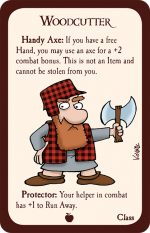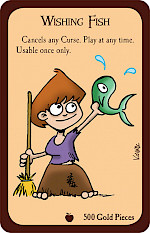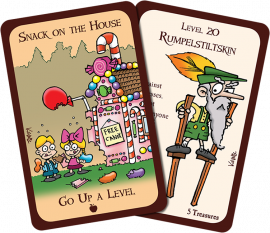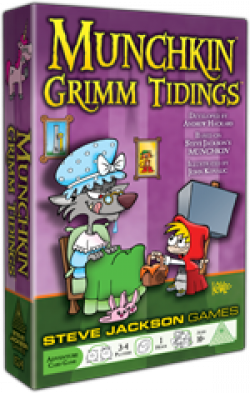Munchkin Grimm Tidings Designer's Notes
by Andrew Hackard
August 26, 2015
When I was working on Munchkin Legends, there was one vein of stories I steered clear of: classic fairy tales. (Not entirely clear of them, but Legends was a big game.) I felt most fairy tales weren't quite "legends" in the way I was using the word in that game, and we had already been talking about the possibility of a fairy tale-themed Munchkin game.
Fast forward a couple of years, and we were having discussions about creating a new literary Munchkin set to follow up Munchkin Oz. After some back and forth, some of which might still come to your store shelves down the road, I remembered our earlier discussion about fairy tales. "What about a Grimm's Tales game?" I asked. "Those originals are certainly violent and bloody enough to form the core of a Munchkin game. We might even have to tone it back a little bit."
Little did I know.
Starting With the Basics
When writing a new Munchkin game, we always start with a few basic questions.
How many cards will it have? Usually 168 in a core game, although there have been exceptions.
In this case, we knew we were going with a smaller set, in the vein of Munchkin Christmas Lite, playable by three or four players. We had been starting to hear some requests from fans for a game that was tailored for smaller groups, and a game designed around that player count could also work as a new set to help introduce Munchkin to a new market.
(A quick aside: Although we didn't know this at the time, our sense of the player count was accurate. We ran a poll in May of 2016 and I summarized the results in an article on Medium.com, in which I said that over half of the respondents said their typical Munchkins game was three or four players.)
My target card count for this game was 112 cards. I ended up with 114 because there were a couple of cards I couldn't bear to cut, and we figured a couple of extra cards wouldn't bug anyone.
Does it use familiar classes, races, etc., or are we writing new ones? Using familiar roles can make the design process easier, but you sacrifice novelty.
For the Grimm set, I felt strongly that the typical fantasy races weren't appropriate. The fantasy classes could have worked, but I thought there were better options that were more closely tied to the stories. New races were a bit thin on the ground in the Grimm tales, and designing a smaller set with both classes and races was going to be challenging, so out they went.
 Once I'd decided to use new classes, choosing them was just a matter of honoring the stories and picking out professions that showed up multiple times and seemed to fit the theme. After some deliberation, we settled on three new classes – Hunter, Tailor, and Woodcutter – and kept the Thief from original Munchkin because these stories have thieves everywhere! I'm very happy with the classes and their abilities; I think they feel fresh and are pretty balanced against each other.
Once I'd decided to use new classes, choosing them was just a matter of honoring the stories and picking out professions that showed up multiple times and seemed to fit the theme. After some deliberation, we settled on three new classes – Hunter, Tailor, and Woodcutter – and kept the Thief from original Munchkin because these stories have thieves everywhere! I'm very happy with the classes and their abilities; I think they feel fresh and are pretty balanced against each other.
Are there any new mechanics we want to include? These include things such as the alternate win conditions of Cthulhu and Apocalypse, the Gear cards in Steampunk, or the various types of stackable monsters found in most of the Munchkin games.
Given that we wanted to make this a more introductory game, and that we had fewer cards to work with, we decided not to include new game features. This game was going to be challenging enough to write as it was.
What's the name? Some Munchkin games name themselves, and our initial thoughts were obvious titles such as Munchkin Grimm and Munchkin Grimm's Tales, but none of them really sang for us. Trying to pun on the word "grim" finally led to Munchkin Grimm Tidings, and that one stuck with everyone. I still hold a little tender spot in my heart for Munchkin Grimmdark, but I think what we settled on was better.
Reading and Writing
Having nailed down the theme and the parameters of the game, it was time to write the thing. And the first step in writing Grimm Tidings was to reread a collection of Grimm's Fairy Tales given to me by my grandparents almost four decades ago. My memories of reading the book were somewhat hazy, although I remembered that a couple of stories were fairly disturbing to my grade-school mind.
Hoo, boy.
Maybe it's that I can now envision some things that I wasn't prepared for as a kid, or maybe it's just that, sadly, I have more experience with atrocities from watching and reading the news, but I think I was more disturbed reading the stories as an adult than I was way back then. These are some seriously dark tales, y'all. The word "Disneyfied" was coined for a reason. The original forms of some well-known children's stories are not what we would consider kid-appropriate. Of course, back in medieval Europe, the stories just reflected the often brutal realities of life. And, sad to say, a couple of stories were completely unusable because of outmoded and unfortunate stereotypes that I won't detail here.
 After a pass through most of the stories, I realized I was too close to them and needed some outside help. So I recruited several of my coworkers, sent them the link to a PDF of a reasonable, good translation of Grimm's Fairy Tales, and scheduled a time for a brainstorming session. I ended up with dozens of fantastic ideas and want to thank Devin Lewis, Randy Scheunemann, Hunter Shelburne, Darryll Silva, Andreas Stein, Ben Williams, and Elisabeth Zakes for picking up on some brilliant Munchkin possibilities that I'd missed in my own reading. Seriously . . . a wish-granting fish? (And here is also where I apologize for not noticing that the credit I meant to give them in the rules got overlooked in the scramble to get Grimm Tidings to print. I'm sorry, gang.)
After a pass through most of the stories, I realized I was too close to them and needed some outside help. So I recruited several of my coworkers, sent them the link to a PDF of a reasonable, good translation of Grimm's Fairy Tales, and scheduled a time for a brainstorming session. I ended up with dozens of fantastic ideas and want to thank Devin Lewis, Randy Scheunemann, Hunter Shelburne, Darryll Silva, Andreas Stein, Ben Williams, and Elisabeth Zakes for picking up on some brilliant Munchkin possibilities that I'd missed in my own reading. Seriously . . . a wish-granting fish? (And here is also where I apologize for not noticing that the credit I meant to give them in the rules got overlooked in the scramble to get Grimm Tidings to print. I'm sorry, gang.)
This collaboration was a lot of fun, and I feel confident we'll do more brainstorming sessions like this in the future. (Actually, as of the publication of this article, we've already done it again . . . for a Munchkin game scheduled for release in 2017 that I can't talk about yet.)
Shaping the Game
Armed with a card list and a framework for a 112-card game, it was time for me to write the thing. I knew I wanted to simplify the game without dumbing it down. This turns out to be harder than it seems. Distilling the Munchkin rules to something that fits on both sides of a legal sheet of paper is an interesting exercise in concision and seeing what game rules you can omit without making it feel like it's no longer a Munchkin game. In the end, we left out a few rules that we could take out as modular chunks (such as Death) and left out some card types that would have required the addition of paragraphs in the rules (notably Super Munchkin, which omission also meant that we never had to address how some Curses and Bad Stuff behaved when you had more than one Class).
In playtesting, people didn't seem to miss those rules. I hope that means I did a good job of writing the game!
 John Comes Through Again
John Comes Through Again
I haven't mentioned the art yet because it deserves its own special section. We commissioned the Grimm Tidings cover well in advance in order to pitch it to buyers at the Dallas Fall Toy Preview last September. As you may realize, in September we were pushing very hard to get the first wave of Guest Artist Editions out the door. Oh, and we were working offsite because of 2015's office flood. Everyone rose to the occasion, but that doesn't mean there weren't some things that were more bugbearish than others.
As it turned out, actually writing Grimm Tidings was one of those things. I ended up running behind deadline and asking John to pull out yet another minor miracle in the form of an entire game's illustrations in far less time than he should have been given. As you'll see from the finished cards, he delivered brilliantly. Thanks again, John.
Now What?
Now I shut up and tell you to go visit your friendly local Walgreens to pick up a copy of Munchkin Grimm Tidings, of course. Thanks for reading and thanks, as always, for playing Munchkin!

